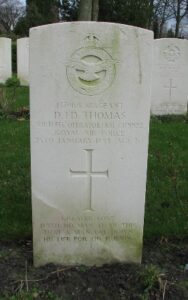The Village of Abergwili sits just to the east of Carmarthen, on the A40 leading out of Town towards Builth Wells. On the main street sits a War Memorial in the style of a Celtic Cross, carved from granite, which remembers the men and one woman of the Village who gave their lives during both World Wars. One man was killed by the IRA after surviving the Great War, and he is remembered on the Memorial also.
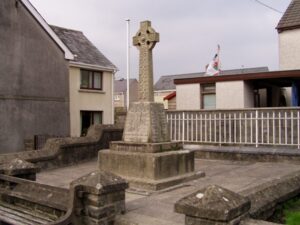
The Great War, 1914-1918
Robert George Duncan Dempster, Private, 227181, Monmouthshire Regiment. Robert was born in 1882, the son of Robert Dempster and Margaret Dempster (nee Evans), of Wiston, Pembrokeshire. He resided with his Aunt, Mrs Evans, at Dolgwili Farm, Abergwili for several years prior to the war, working as a Clerk and was secretary of the Abergwili Show. Robert enlisted at Newport into the 2/1st Battalion, Monmouth Regiment soon after its formation at Newport on 20 February 1915 as part of the Welsh Border Brigade, Welsh Division, which was later numbered as 205 Brigade, 68th (2nd Welsh) Division, and remained on Home Service until the Division was disbanded on 31 March 1918. The men of the 2/1st Monmouth’s were used as reinforcements for the 1/1st Battalion, Monmouthshire Regiment, which was by then the Pioneer Battalion to the 46th (North Midland) Division. Robert was drafted to France in the summer of 1916 to join the 1/1st Battalion, Monmouthshire Regiment. The 46th Division had just returned to France following a very brief spell in Egypt, moving to positions on the Somme. Here the Division took part in a diversionary Attack on the Gommecourt Salient on 1 July 1916, which was intended to draw attention away from the main attack on the Somme, but suffered terrible casualties. The division then rested and refitted for several months at Arras, returning to the Somme at the end of 1916 to take part in Operations on the Ancre. During March 1917 the Division followed the German Retreat to the Hindenburg Line, and then fought in the Battle of Arras, taking part in the Battle of Hill 70. In 1918 the Division took part in the Advance in Flanders, and then moved south, where it was tasked with the breaking of the Hindenburg Line. The division fought at the Battle of the St Quentin Canal at the end of September, where its 137 Brigade completed one of the finest feats of arms in British military history, forcing the crossing of the St Quentin Canal at Riqueval on 29 September. With the mighty Hindenburg Line now breached, the Division continued its advance. The 1st Monmouth’s had moved into position on 2 October, in preparation to join the offensive and at dawn on 3 October 1918 launched an assault against the villages of Ramicourt and Montbrehain, as part of the Battle of the Beaurevoir Line. Robert was badly wounded during the fighting here and was evacuated from the front, dying of his wounds at the 12th Casualty Clearing Station at Tincourt on 10 October 1918. The 36-year-old was buried in Tincourt New British Cemetery, France. A brother, Harry Duncan Dempster, was killed in 1915 and is commemorated at Clarbeston Road and Wiston, alongside Robert.
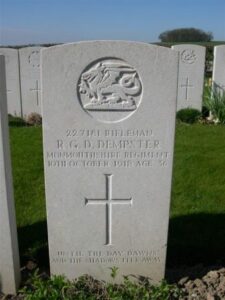
Mary Evans, Nurse, Edmonton Military Hospital. Mary was born near Meidrim in 1888, the daughter of John and Elizabeth Evans (nee Reynolds). The family later moved to Derwen House, Priory Street, Carmarthen. She had worked as a Nurse at Edmonton Military Hospital, which was a Special Military Surgical Hospital, specialising in orthopaedics, for over eighteen months. Sadly Mary became one of four nurses at the Hospital to die of influenza within just four days of each other just after the end of the war, with Mary dying on 15 October 1918, aged 28. She was buried with full military honours at Abergwili Churchyard. On 6 July 1921 a Memorial was erected in the memory of the nurses, at the Chapel of the then renamed North Middlesex Hospital.
Arthur Fallon, Private, 13103, Welsh Regiment. Arthur was born in Worcestershire in 1893, and was the brother of Frances Fallon. The two siblings had been raised in a home in Kidderminster but moved to west Wales prior to the war. Records show that Arthur resided at Abergwili prior to the war, and was well known at Llangunnor, through working for Colonel William Charles Aslett at Bolahaul Farm, Llangunnor. Arthur enlisted at Carmarthen soon after the outbreak of war, into the 8th Battalion, Welsh Regiment. The battalion was formed at Cardiff in August 1914, moving to Salisbury Plain to join 40 Brigade, 13th (Western) Division. The battalion moved to Chiseldon in October then in December moved again to billets in Bournemouth, where it became converted to the Pioneer Battalion to the 13th Division. In February 1915 the division moved to Aldershot to complete its training, then on 15 June 1915 sailed from Avonmouth for Mudros, before being landed ashore at Anzac, Gallipoli on 5 August 1915, to fight alongside the Anzacs in a great diversionary attack. The 8th Welsh, now reverting to its infantry role, marched out from Anzac Cove on the following day and took up reserve positions at the mouth of Chailak Dere. The 13th Division launched a great assault on Chunuk Bair on 7 August and took its objectives, despite heavy losses, so at dawn on 8 August 1915 the 8th Welsh moved forwards, supported by the heavy guns of the ships deployed offshore. As the battalion crossed Apex Ridge, the men were mown down by heavy machine-gun fire and was almost decimated. Following a terrible time at Gallipoli, the Division was evacuated to Egypt on 8 January 1916, concentrating at Port Said, where it held forward posts in the Suez Canal defences. On 12 February 1916 the Division began to move to Mesopotamia, to strengthen the force being assembled for the relief of the besieged garrison at Kut al Amara. By 27 March, the Division had assembled near Sheikh Saad and came under orders of the Tigris Corps, and then took part in the attempts to relieve Kut. However, after these efforts failed and Kut fell, the British force in the theatre was built up and reorganised. Arthur sadly died of heat exhaustion in Mesopotamia on 29 June 1916. The 23-year-old was buried in Amara War Cemetery. His only known relative, his sister, Frances, married Archibald Joseph Cole in 1919 and the couple resided at Manordeilo. Arthur is commemorated at Babell Chapel in Llangunnor but is not commemorated on the Abergwili war memorial.
David Thomas Harries, Private, 39828, South Wales Borderers. David was born in 1895, the son of David Harries and Margaret Harries of 3, Caxton Place, Abergwili. He worked as a messenger for a drapery store in Carmarthen prior to the war. David enlisted at Carmarthen into the Pembroke Yeomanry and was posted to France in the spring of 1916, joining the 2nd Battalion, South Wales Borderers, which was attached to 87 Brigade, 29th Division. The Division had landed at Marseilles on 15 March 1916, following much fighting in Gallipoli, and had rebuilt in Egypt before being transferred to the Somme front. It then saw its first action in France during the opening assault of the Battle of the Somme on 1 July 1916, suffering terrible casualties at Y-Ravine. The 2nd SWB alone suffered some 384 casualties on that day alone. Although severely depleted, the Division remained in the line here over the coming weeks, in trying conditions. The Division was then pulled out of the line to rest and rebuild in the Ypres Salient, before moving back into the line on the Somme by 13 October and taking part in the latter stages of the Somme offensive. The 2nd SWB moved through Bernafay Wood on 19 October, then marched through the ruins of Longueval to positions in a sunken road southwest of Gueudecourt, before taking over Grease Trench on the following morning. The battalion then came under heavy artillery fire, suffering a number of casualties during that first day back in the Somme trenches. David was posted as missing, believed killed in action, on 20 October 1916. The 21-year-old has no known grave, so is commemorated on the Thiepval Memorial, France.
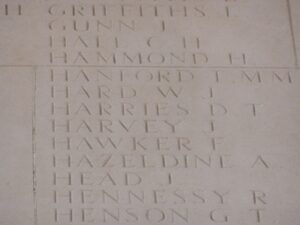
Daniel Howell, Private, 113, Royal Warwickshire Regiment. Daniel was born in 1894, the son of David Howell and Margaret Howell (nee Davies), of Werndrevi Cottage, Abergwili. By 1911 he was lodging with his sister Hannah, and her husband Frederick William Phillips at 32, Inderwick Road, Stroud Green, London, working as a Clerk for an electrical engineering company, but by the time war broke out was working in Birmingham. As a result, he enlisted there into the 14th Battalion, Royal Warwickshire Regiment, known as the 1st Birmingham Battalion. The battalion was raised at Birmingham by the Lord Mayor and a local committee in September 1914, moving to Sutton Coldfield. On 25 June 1915 the battalion moved to Wensleydale to join 95 Brigade, 32nd Division, and six weeks later moved to Salisbury Plain. On 21 November 1915 Daniel landed with the battalion at Boulogne and moved to Vignacourt, on the Somme. On 26 December the battalion transferred to 13 Brigade, 5th Division and began its first tour in the trenches at Carnoy. The battalion remained in this area over the coming weeks, carrying out a lot of pioneer duties, such as digging trenches and laying wire and on 9 January 1916 moved out of the line to Vaux-sur-Somme, proud of the work done on their old trenches. Here the battalion found itself isolated from the rest of the division due to an outbreak of German Measles, and it was not until 6 March that the last cases had gone away and the battalion began marching to the Arras sector, to join the remainder of the division. Over the coming days the men marched through Villers Boucage, Doullens, Grand Rollicourt and Agnez and on 15 March took over trenches in the Arras Sector. Again, as well as holding the line, the men were put to work, carrying out mining and other improvements. The battalion was in the front line trenches at Arras, when Daniel was shot by a sniper, and killed on 25 March 1916. The 21-year-old was buried in Cabaret Rouge British Cemetery, Souchez, France. His grave is marked by a Special Memorial, as he is known to be buried there, but the exact whereabouts of his grave was lost.
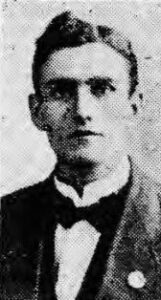
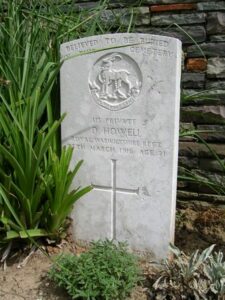
Walter James, Private, 203066, South Lancashire Regiment. Walter was born in 1885, the son of Thomas James and Rachel James (nee Harries), of Llettywithig Farm, Abergwili. Walter enlisted into the army at Llanelli, probably the 4th Battalion, Welsh Regiment, but became transferred to the 2/4th Battalion, South Lancashire Regiment. The battalion had formed at Warrington in September 1914, moving to Ashford in February 1915 to join 172 Brigade, 57th Division. In June 1916 the division moved to Mytchett, Aldershot, then in October 1916 to Blackdown. On 16 February 1917 the division landed at Boulogne and moved to the ‘Nursery Sector’ around Armentieres. The 2/4th South Lancs moved into trenches near Bois Grenier on 24 February to begin its first tour in the front line in what was by now a relatively quiet sector. Over the coming weeks the battalion carried out the by now usual routines of four days in the trenches, four in support and four in reserve, as the men acclimatised to life at the front. On 1 April the battalion moved to the Laundries at Erquinghem and remained there for ten days before marching back towards the line and on 13 April moved into trenches in the Rue du Bois Sector. Walter was wounded by shellfire during this tour in the trenches and was evacuated to Hazebrouck, where he died of his wounds on 19 April 1917. The 32-year-old was buried in Hazebrouck Communal Cemetery. Walter is not commemorated at Abergwili, possibly as his parents had by now retired from farming and moved to Wauniago, Picton Place, Carmarthen.
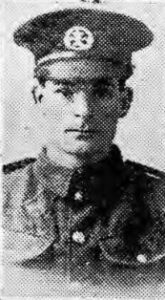
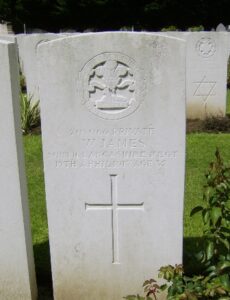
Daniel James Jones, Gunner, 79521, Machine Gun Corps (Motors). Daniel was born in 1899, the son of Daniel Jones and Ann Jones, of 29, High Street, Abergwili. He worked for his father at Gwynfa Motor Garage, Abergwili prior to the war. Daniel enlisted at London into the Army Service Corps, and was transferred into the 1st Battery, Motor Machine Gun Service. The Motor Machine Gun Service (MMGS) was a unit raised at the outbreak of the war, consisting of batteries of motorcycle/sidecar combinations carrying Vickers machine guns. It was formed in 1914 and incorporated into the Machine Gun Corps in October 1915 as the Machine Gun Corps (Motors). Daniel’s Battery had been in France since January 1915 and had seen extensive service by the time he arrived in France, probably in the summer of 1916. The Battery was in reserve at Fosseux when the Allies launched their great offensive on 21 August 1918, then on 21 September moved to Proven, where it was shelled out of its billets on 26 September 1918. Daniel was the sole man of his unit killed during the bombardment that day. The 19-year-old was buried in Mendinghem Military Cemetery, Proven, Belgium.
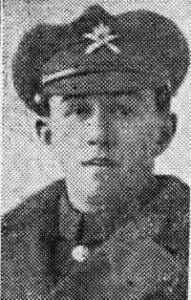
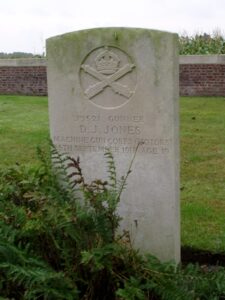
Herbert James Jones, Sapper, 96505, Royal Engineers. Herbert was born in 1884, the son of John Jones and Harriet Jones (nee Davies), of Llanarthney. The family then moved to 37, High Street, Abergwili several years prior to the war, and Herbert married Edith Florence Stork there in 1909. The couple then moved to Eiros Cottage near Llandebie, where Herbert worked as a miner, then moved again to Edith’s native London and settled at Murray Arms, 81, Paul’s Road, Camden Town, London. Herbert enlisted in London into the Royal Engineers and due to his mining experience, was posted to the 171st Tunnelling Company, Royal Engineers. The Company had been formed between February and March 1915 from a small number of specially enlisted miners, with troops selected from the Monmouthshire Siege Company of Royal Engineers and as a result comprised of a large number of miners from South Wales. The Company then moved to the Ypres Salient, under the command of the Second Army and was first employed in March 1915 in the Hill 70 and the Bluff area near Ypres, where it began one of the most terrifying campaigns of the Great War, the war underground. The tunnellers dug a network of dugouts, subways and mines around the Ypres Salient, and the men manning the trenches above grew to fear the sound of digging beneath their feet, after the explosion of several mines in the sector. On 2 June 1915, Herbert was at work underground in the Hill 60 Sector, when the Germans blew a camouflet, a small mine designed to collapse galleries. One man of Herbert’s Company became trapped, so Herbert and some other Sappers attempted a rescue. Herbert died underground that day as a result of lack of oxygen. The 31-year-old has no known grave and is commemorated on the Menin Gate Memorial at Ypres.
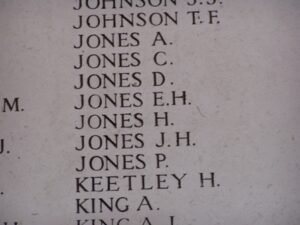
Thomas Lloyd, Private, 63126, Welsh Regiment. Thomas was born in 1898, the son of Thomas Lloyd and Rachel Lloyd, of 58, High Street, Abergwili. He worked as a farm labourer as a young man, then left Abergwili to work as a tinplater at Llanelli. Thomas enlisted at Llanelli into the 4th (Reserve) Battalion, Welsh Regiment on 23 October 1914, and was posted to the 1/4th Battalion, Welsh Regiment. The battalion was the local Territorial unit and mobilised for war at Carmarthen in August 1914, as part of South Wales Brigade, Welsh Division and moved to Tunbridge Wells until the end of the month, before moving to Scotland to man the Forth and Tay Defences. The remainder of the Welsh Division then moved to Bedford, where it became numbered as the 53rd (Welsh) Division, and on 17 April 1915 the 4th Welsh moved to Bedford, joining 158 Brigade, of the 53rd (Welsh) Division. On 19 July 1915 the entire Division sailed from Devonport for Imbros and on 9 August 1915 landed at C Beach, south of Lala Baba, in Suvla Bay. The infantry moved off the beaches across the Salt Lake, under shellfire, into the scrub covered Chocolate Hill, but due to a lack of maps and no knowledge of the terrain, many of the units became disorientated, and the situation became chaotic. Thomas survived this terrible period, but became ill and was admitted to the 87th Field Ambulance on 13 September and was evacuated to Mudros before returning back to England aboard the Hospital Ship Aquitania. It was over a year before he had recovered enough to go back to the front, and in February 1917 he left England for Salonika, to join the 11th Battalion, Welsh Regiment, which was attached to 67 Brigade, 22nd Division. Thomas then suffered several spells of ill health in Salonika over the coming months, but was fit for action again by the summer of 1918. He was then wounded in action during the Battle of Doiran and died of his wounds on 21 September 1918. The 21-year-old was buried in Sarigol Military Cemetery, Kriston.
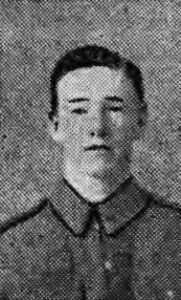
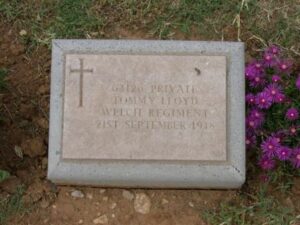
David Idwal Morris, Private, 57145, Welsh Regiment. David was born in 1896, the son of Jared Morris and Elizabeth Morris (nee Thomas), of Myrtle Farm, Abergwili. The family later moved to Capel Dewi Issaf, near Abergwili. David worked for his father prior to enlisting at Nantgaredig into the Pembroke Yeomanry on 10 December 1915, and was put on the Army Reserve. He was mobilised on 11 January 1916, and posted to the 3/1st Battalion, Pembroke Yeomanry, with the service number 5119, and joined the battalion in Ireland. In August 1916 David was transferred to the 4th (Reserve) Battalion, Welsh Regiment and was drafted to the Infantry Base Depot in France, before being posted to the 16th Battalion, Welsh Regiment, which was attached to 115 Brigade, 38th Welsh Division, on 1 September. By now the Division had moved from the Somme, where it had taken Mametz Wood, to positions just north of Ypres, along the canal at Boesinghe. The infantry battalions of the Division then began carrying out the normal pattern of rotation in the trenches, four days in the front, four in support and four in reserve, whilst also working on trench improvement, digging new trenches, and also carrying out regular patrols and trench raids. On 31 July 1917 the Division launched its famous assault on the Pilckem Ridge, capturing Iron Cross and reaching its objective of the Steenbeek, then played a supporting role in the Battle of Langemarck. The 16th Welsh moved into Eagle Trench on 26 August, relieving the 15th RWF, with orders to attack on the following day, in support of an assault by the 20th (Light) Division on Langemarck. It was during an abortive assault near Eagle Trench, Langemarck, that David was Killed in Action on 27 August 1917. The 21-year-old has no known grave, so is commemorated on the Tyne Cot Memorial, Belgium. David is commemorated on the Nantgaredig War Memorial, but not at Abergwili.
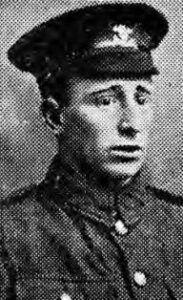
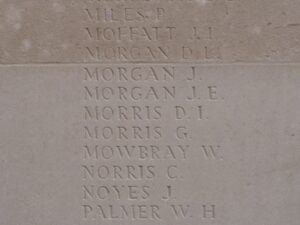
Stephen David Morris, Private, 52753, Cheshire Regiment. Stephen was born in Abergorlech in 1891, the son of Richard Morris and Ann Morris (nee Griffiths). His parents had taken over the Drover’s Arms at Abergwili by 1901, and then the Black Ox, at Abergwili. Stephen left home as a young man to work as a Grocery Assistant and by 1911 was lodging at 7, Bute Street, Aberdare. He was lodging at 7, Pleasant View, Tylorstown when war erupted and enlisted into the 21st Battalion, Welsh Regiment at Porth on 9 December 1915. Stephen was initially placed on the Army Reserve, and was not mobilised until 24 March 1916 when he attested at Cardiff and was posted to France on 28 June 1916, joining the 13th Battalion, Welsh Regiment, which was on the Somme, attached to 114 Brigade, 38th (Welsh) Division. He would possibly have taken part in the Divisions famous assault on Mametz Wood the following month. On 1 September Stephen was transferred into the 11th Battalion, Cheshire Regiment, which was attached to 7 Brigade, 25th Division. On 31 October 1916 the Division moved to the Ploegsteert Sector, and took part in the opening of the Passchendaele Offensive, the Battle of Messines Ridge, on 7 June 1917. Stephen was wounded at Messines, and sadly died of his wounds at the Casualty Clearing Station at Bailleul on 8 June 1917, aged 26. He is buried in Bailleul Communal Cemetery Extension, France.
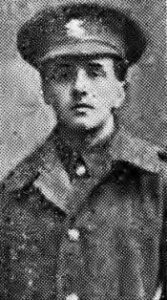
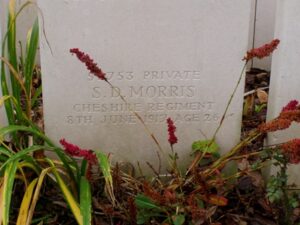
William Owen, Private, 240782, Welsh Regiment. William was born at Abergwili in 1886, the son of John Owen and Elizabeth Owen. The family later resided at Penrheol, Capel Gwyn, White Mill, while William left home to find work as a collier, and lodged at 39, Abercynon Road, Abercynon. He enlisted at Pontypridd into the 1/5th Battalion, the Welsh Regiment soon after the outbreak of war. The battalion was the local Territorial unit and mobilised for war in August 1914, as part of South Wales Brigade, Welsh Division and moved to Tunbridge Wells until the end of the month, before moving to Scotland to man the Forth and Tay Defences. The remainder of the Welsh Division then moved to Bedford, where it became numbered as the 53rd (Welsh) Division, and on 17 April 1915 the 5th Welsh moved to Bedford, joining 158 Brigade, of the 53rd (Welsh) Division. On 19 July 1915 the entire Division sailed from Devonport for Imbros and on 9 August 1915 landed at C Beach, south of Lala Baba, in Suvla Bay. The infantry moved off the beaches across the Salt Lake, under shellfire, into the scrub covered Chocolate Hill, but due to a lack of maps and no knowledge of the terrain, many of the units became disorientated, and the situation became chaotic. After the fighting died down, the winter rolled in, and the men first had to endure torrential downpours, which flooded the trenches, before the snow hit, and many men began falling ill in the terrible conditions. The Division was eventually evacuated from Gallipoli in December 1915, moving to Egypt to join the EEF, and helped guard the Suez Canal before taking part in operations to drive the Turks out of the Sinai. The EEF then turned its attention onto driving the Turks out of Palestine, and on 26 March 1917 launched its first offensive against the coastal city of Gaza, which guarded the road to Jerusalem. Initial gains during the day were lost when the assaulting divisions lost touch with each other and communication broke down when a thick fog cloaked the battlefield. A second attempt to force Gaza was launched on 17 April, which also failed, and the EEF suffered a change in leadership, with Sir Edmund Allenby assuming command, before being re-organised, and a third offensive was launched against a wider front from Beersheba to Gaza on 31 October 1917. This time the Turkish defences were breached, and the road to Jerusalem now lay open and the EEF began to advance north. On 6 November 1917, 158 Brigade launched an attack on the Khuweilfeh Heights, and once secured, the EEF continued its advance into the Judean Hills, the 53rd Division capturing Hebron and Bethlehem, before securing the Jerusalem to Jericho road. William had by now been evacuated from Palestine to the Hadra Hospital at Alexandria. He died of malaria there on 9 December 1917. The 31-year-old was buried in Alexandria (Hadra) War Memorial Cemetery, Egypt. William is not commemorated at Abergwili.
Joe Anthony Francis Parkinson, Lieutenant, Dorsetshire Regiment. Joe was born on 28 February 1888, the son of Thomas Parkinson and Ada Blanche Parkinson (nee Beresford), of Castell Pigyn, Abergwili. His father Thomas was J. P. for Carmarthenshire. The family later resided at Newent Court, Newent, Gloucestershire. Joe was educated at Rossall from 1901 to 1905, and joined the Dorsetshire Regiment from the Special Reserve in 1910, becoming Lieutenant in March 1912. At the outbreak of the Great War, Joe moved to France with the 1st Battalion, Dorsetshire Regiment, which was attached to 15 Brigade, 5th Division. The Division had landed at Havre on 15 August 1914, and fought at the Battle of Mons, and during the retreat south, fighting at Le Cateau, then down to the Marne where the German attack was halted. The Division then took part in the advance to the Aisne, before moving to Flanders, where it fought at the Battle of La Bassée, and saw further fighting at Messines in October 1914. Joe was killed when the Dorsets trenches came under heavy German artillery fire on 13 October 1914, and he was struck by shrapnel. The 26-year-old has no known grave, and is commemorated on the Le Touret Memorial, Richebourg L’Avoue, France. His elder brother was Lieutenant-Colonel Thomas William Parkinson, the Commanding Officer of the Carmarthen Pals battalion. Joe does not appear to be commemorated anywhere in Carmarthenshire.
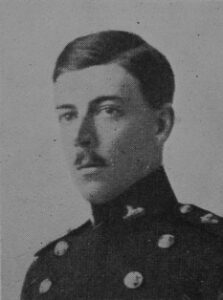
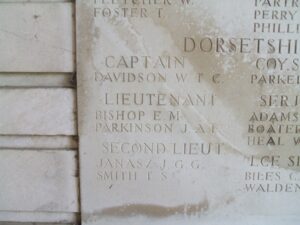
John Clarke Phillips, Private, 790, Australian Imperial Force. John was born at Abergwili in 1874, the son of David Benjamin Phillips and Harriet Phillips (nee Llewellyn). He was baptised at Abergwili on 26 April that year. He married Hannah Maria John at St. Mary’s Church, Swansea on 12 October 1899 and the couple emigrated to Australia with their two young daughters in September 1913. The family then settled at Stanley Terrace, Leabrook, South Australia, where John worked as a Tram Inspector. John enlisted at Adelaide on 17 February 1916 into the 43rd Battalion, Australian Infantry. He embarked at Adelaide on 9 June 1916 aboard HMAT Afric, and disembarked at Marseilles on 20 July 1916. The battalion then moved to Britain for further training, before moving to the Western Front early in December 1916, joining the 11th Brigade, 3rd Australian Division. The Division moved to Bailleul by 25 November 1916, then to the Armentieres Sector, where it began its routine of trench warfare. John was killed here by a German bombardment on 26 January 1917. He was 45 years old, and is buried at Cite Bonjean Military Cemetery, Armentieres, France. John is not commemorated locally.
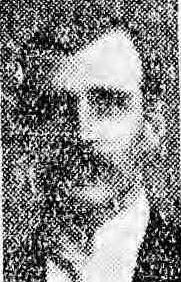
Dan Ivor Price, Private, 40048, Royal Welsh Fusiliers. Dan was born in 1896, the son of David Price and Margaret Elizabeth Price (nee Davies), of Peniel School House, Abergwili. His father was the Schoolmaster at Abergwili for several years prior to moving with the family to Chapel House, Peniel, following the death of his wife. Dan was educated at Carmarthen Grammar School, and moved to Tumble prior to the war, gaining work there as a school teacher. Dan left his job as a teacher at Tumble to enlist at Carmarthen into the 22nd Battalion, Royal Welsh Fusiliers on 10 December 1915, and was initially placed on the Army Reserve. He was mobilised on 21 January 1916, travelling to Conway to then join the battalion at Kinmel Park. On 28 July 1916 Dan was drafted to France and two days later was posted to the 1st Battalion, Royal Welsh Fusiliers, which was on the Somme, attached to 22 Brigade, 7th Division. The Division had taken part in the opening assault of the Somme offensive on 1 July 1916, advancing from positions near Bois Francais, near Fricourt, and capturing the village of Mametz, one of the few successes of 1 July 1916. The battalion then took part in further attacks to push forwards, to the south of Mametz Wood, and upon being relieved, witnessed the troops of the 38th (Welsh) Division moving forward to launch its assault on Mametz Wood. On 14 July, with the wood taken, the 7th Division moved back into the line, with orders to capture Bazentin-le-Petit, before taking part in the terrible attacks on High Wood over the coming days. On 22 July the 1st RWF was relieved, moving back into reserve to rest and rebuild at La Chaussee. By 12 August the battalion had moved forwards to Dernancourt, and on 26 August marched further forward, to take part in the Divisions assault on Ginchy. The Division saw heavy fighting over the coming days, before the 1st RWF had another short break, but on 1 September the battalion received orders to push forwards again to launch a fresh assault on Ginchy from Montauban Alley. On 3 September 1916 the 1st RWF launched its assault, but suffered severe casualties, with over 200 officers and men killed, wounded or missing. The division was then relieved and transferred north to the Ypres Salient to rest and rebuild, in positions near Ploegsteert Wood, but at the beginning of November was ordered to move south, back to the Somme Sector, where it wintered. On 25 February 1917 patrols discovered that the Germans had evacuated Serre, so the 1st RWF received orders to advance and seize the village of Puisieux. Dan was killed in action here on 26 February 1917, when the advancing troops became held up by intense German artillery fire. The 20-year-old has no known grave and is commemorated on the Thiepval Memorial, France. Dan is not commemorated at Abergwili.
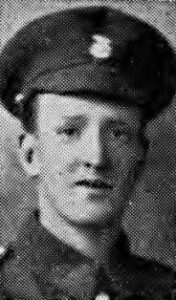
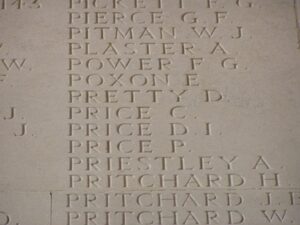
Lloyd Owen Lloyd Price, Rifleman, R/5798, King’s Royal Rifle Corps. Lloyd was born in 1884, the son of Meredydd Lewes Willy Lloyd Price and Frances Margaret Lloyd Price (nee Lloyd), of Castle Pigyn, Abergwili. His father was a Solicitor and later moved the family to Bryn Cottage, Nantgaredig. When war broke out, Lloyd was in Rhodesia, working as a Mining Engineer. He returned to Britain to enlist on 13 October 1914, and enlisted into the Kings Royal Rifle Corps at Winchester on 13 October 1914. Lloyd was drafted out to France on 23 November 1914, joining the 2nd Battalion, King’s Royal Rifle Corps, which was attached to 2 Brigade, 1st Division, and had been on the Western Front since the outset of war, fighting in the tremendous rearguard actions of Mons and Le Cateau and ended up on the Marne, where the German drive on Paris was stopped at the Chemin Des Dames Ridge. Just before Lloyd joined the 2nd KRRC, the battalion was in trenches near Hooge, to the east of Ypres. The battalion endured a torrid time here, constantly under shellfire and German attacks, in terrible conditions, but was relieved on 16 November and moved to Westoutre to rest and refit. It was here that Lloyd joined his battalion, on 23 November. The Division then moved to the Cambrin Sector, another terrible place, near Loos and started off the New Year beating off German attacks along their lines. On 3 January the battalion was relieved and marched back to billets at Cambrin, from where the men were sent in batches to Bethune to enjoy hot baths. On 8 January the battalion moved back into the trenches, which were in a terrible condition, flooded and muddy, so the men were put to work improving them, before preparing to launch an attack against the Germans. Lloyd is recorded as having died in unknown circumstances during this attack, at Cuinchy on 10 January 1915. The 30-year-old has no known grave, so is commemorated on the Le Touret Memorial, Richebourg L’Avoue, France. Lloyd does not appear to be commemorated anywhere locally.
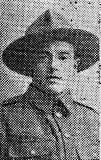
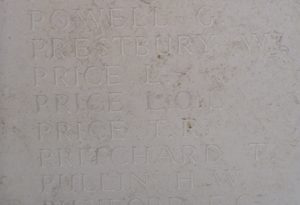
W. M. Rees, Private, Australian Forces. The War Memorial at Abergwili shows that Private Rees died during August 1917. At present no records can be found of him, as no man of that name served with the AIF.
Edward Rockingham, Private, 320155, Welsh Regiment. Edward was born at Norwood, Surrey on 23 September 1895, the illegitimate child of Ellen Rockingham, a domestic servant. He was brought up in a home and came to Abergwili after 1911, where he worked for Mrs. Rees, Penybont. He enlisted at Carmarthen into the Pembroke Yeomanry, Army Number 2237. The Pembroke Yeomanry moved to Egypt in 1916, where it merged with the Glamorgan Yeomanry to become the 24th Battalion, Welsh Regiment, part of 231 Brigade, 74th Yeomanry Division, and fought in Palestine as a dismounted infantry unit. Early in 1918 when the tide of war was turning in favour of the Germans, with big breakthroughs on the Somme and in Flanders, the 74th Division was sent back to France, landing during May, 1918. They were rushed to Flanders, where they helped stem the German advance, before moving south, pushing against the Hindenburg Line around the Épehy area. Edward was killed during heavy fighting at Gillemont Farm on 21 September 1918, during the Battle of Épehy. Edward has only recently been accepted for commemoration by the CWGC, after evidence of his omission was presented to them by myself. He will be commemorated on the Vis-en-Artois Memorial, France, after 91 years of being forgotten.
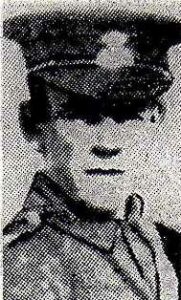
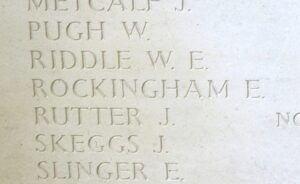
Arthur Edward Thomas, Private, 957, Essex Regiment. Arthur was born in Beckenham, Kent in 1879, the son of Thomas Jeremy Thomas and Mary Griffith Thomas (nee Lewis). His father was a warehouseman and merchant from Carmarthen, whilst his mother was from Abergwili. His mother died in 1891 and Arthur was sent to Millbrook School in Hampshire for his education. Arthur worked as a farm labourer prior to enlisting at Bradfield, Essex into the 1/5th Battalion, Essex Regiment. The battalion mobilised at Chelmsford on 4 August 1914, as part of Essex Brigade, East Anglian Division, before moving to Norwich. In April 1915 the Division moved to Colchester where it became renumbered as the 54th (East Anglian) Division and on 21 July 1915 sailed from Devonport for Gallipoli. The Division landed at Suvla Bay on 12 August 1915 in order to join the last great push to seize the Peninsula. Unfortunately, the landings were a failure and the campaign bogged down into stagnant trench warfare again. Arthur took ill on Gallipoli and was evacuated by Hospital Ship to the 15th General Hospital at Alexandria, in Egypt, where he died of dysentery on 27 September 1915. The 36-year-old is buried in Alexandria (Chatby) War Memorial Cemetery, Egypt. Arthur is not commemorated locally.
Herbert Gordon Thomas, Second Lieutenant, Royal Welsh Fusiliers. Herbert was born in 1884, the son of the Reverend Thomas Thomas and Mary Anne Lucas Thomas (nee James), of the Vicarage, Abergwili. Herbert was educated at Llandovery College from 1898 to 1904 and then at Oxford before becoming a schoolmaster, and resided at 90, Norfolk House, Knotty Green, Beaconsfield, Buckinghamshire by 1911. Herbert enlisted into the army early in 1916 and on 27 April 1916 was commissioned as Second Lieutenant into the 3rd Battalion, Royal Welsh Fusiliers, which was a Home Service Battalion. Upon completing his training, he was posted to France, where he joined the 10th Battalion, Royal Welsh Fusiliers, which was attached to 76 Brigade, 3rd Division. Herbert joined the battalion at Noeux Les Mines on 31 August 1916, together with two other officers and 24 other ranks. The battalion was rebuilding following a torrid time on the Somme, where it had suffered terribly during the fighting for Delville Wood and Lonely Trench. After a month there, the Division moved back into a rest area for further training before moving back south to the Somme and by 12 November took over trenches at Serre. On the following day, 13 November 1916, the Division launched an assault against the German positions at Serre. The 10th RWF reached Serre village, but the flanking battalions failed to keep up, and heavy losses were suffered, with almost 300 officers and men killed, wounded, or missing, most of the officers in the leading waves were killed that day, including Herbert. The 31-year-old is buried in Euston Road Cemetery, Colincamps, France.
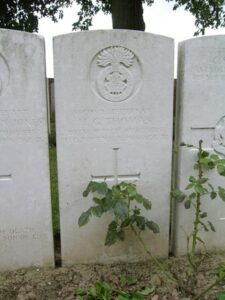
John Thomas, Private, 2029, Australian Imperial Force. John was born in about 1883, the son of John Thomas of Abergwili. He worked as a miner prior to emigrating to Australia, where he again took up work as a miner, near Brisbane. He enlisted at Brisbane on 27 January 1915 into the 9th Battalion, Australian Infantry, and embarked at Brisbane on 16 April 1915 HMAT Kyarra for Egypt. On 22 June 1915 John joined the battalion at Gallipoli, and fought at the Battle of Lone Pine in August. He then took ill, and was evacuated from Gallipoli, suffering from dysentery and diphtheria. It wasn’t until 25 February 1916 that John was well enough to return to duty, and was posted to the 49th Battalion, Australian Infantry. The battalion was formed by the doubling of the AIF, with half of its number being made up from 9th Battalion men, and joined the newly formed 13th Brigade, 3rd Australian Division. Arriving in France on 12 June 1916, the Division saw its first major battle at Mouquet Farm in August. John, serving as a machine-gunner, was wounded by a shell fragment during an attack at Mouquet Farm on 3 September 1916, and died two hours later. The 32-year-old was buried on the battlefield, but his grave was never identified, so he is today commemorated on the Villers Brettoneux Memorial, France. John is not commemorated on the Abergwili Memorial.
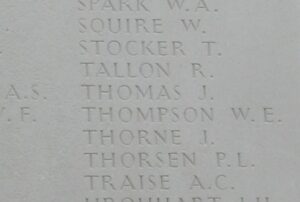
John Thomas, Driver, 43259, Royal Field Artillery. John was born at Penygaer in 1893, the son of John Thomas and Jane Thomas (nee Rees). His father died in 1903, and Jane married William Walters, of 13, White Mill, Abergwili in 1906. John enlisted at Ammanford into the Royal Field Artillery soon after the outbreak of war, and was posted to the 13th Division. The Division came into existence during August 1914 and concentrated at Blackdown, Hampshire. By mid June 1915 the Division had been ordered to the Mediterranean, arriving at Mudros on 4 July 1915. From 6 July 1915 the Division landed at Cape Helles, and then moved to Anzac Cove by early August, taking part in the Battles of Sari Bair, Russells Top and Hill 60. John was taken ill at Gallipoli, due to the terrible insanitary conditions on the Peninsula. He was evacuated by Hospital Ship to the main Hospital at Alexandria, where he died of dysentery on 14 November 1915. The 22-year-old is buried in Alexandria (Chatby) Military Cemetery, Egypt.
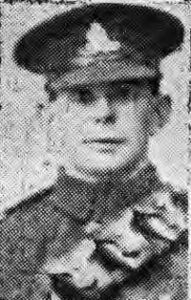
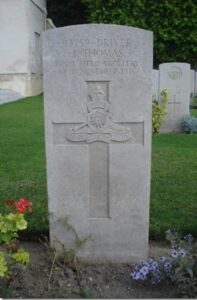
Thomas Thomas, Private, 238185, West Riding Regiment. Thomas was born in 1896, the son of David Thomas and Mary Thomas (nee Davies), of Cross Road, Abergwili. Following the death of his mother in 1907, the family moved to Rhydlydan, Nantgaredig. Thomas enlisted at Nantgaredig into the 4th (Reserve) Battalion, Welsh Regiment, but was then transferred to the West Yorkshire Regiment. Upon being drafted to France he was transferred again, and posted to the 2/4th Battalion, West Riding Regiment, which was attached to 186 Brigade, 62nd Division. During January 1917 the Division moved to France, seeing action on the Ancre, before following the German retreat in 1917 to the Hindenburg Line. The Division took part in the Battle of Bullecourt during May 1917, and also the Battle of Cambrai during November and December that year. In early 1918 the Division was stationed at Bucquoy near Arras when the German Spring Offensive was launched on 21 March 1918 and made a heroic stand, surviving ten days of the most terrible fighting they had seen, before being relieved at the end of March. In May, the German attacked French positions near Reims, and a British Corps, including the 62nd Division, were rushed south to plug the gaps in the line there. After the line around Reims had been stabilised, the Division moved north to the old Somme area, taking the village of Mory on 25 August, and pushing forward toward Vraucourt and Vaulx-Vraucourt. Thomas was Killed in Action during this advance, on 2 September 1918. The 22-year-old was buried in Vaulx Hill Cemetery. The CWGC have made an error with the carving of Thomas’s initial, placing J. Thomas on his headstone.
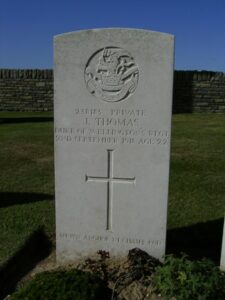
Joseph Longstaff Watson, Lieutenant, Canadian Infantry. Joseph was born at Banchory, Scotland on 4 May 1891, the youngest son of Charles France Watson and Florence Watson (nee Longstaff). His parents died when he was just 13, and Joseph came to live with his Aunt, Mrs. Owen, the wife of the Bishop of St. Davids, at Abergwili Palace. Joseph had emigrated to Canada prior to the war and worked as a Rancher prior to enlisting into the Canadian Expeditionary Force at Victoria, British Columbia, on 9 February 1915. He was then posted to the 30th Battalion, Canadian Infantry, as a Private, with the service number 77958, before being posted to the 16th Battalion (Manitoba), Canadian Infantry, which was attached to the 3rd Brigade, 1st Canadian Division. Joseph would have been in France by June 1915, and probably fought at Givenchy that month. In 1916, the 1st Canadian Division fought at Mount Sorrel, south of Ypres. Joseph was wounded here, suffering shrapnel in his buttock, and was treated at the 14th General Hospital Wimereux, before being sent back to Britain and admitted into the 1st Scottish General Hospital at Aberdeen. It was not until September that he had recovered enough to rejoin the Canadian Infantry Depot at Epsom, but was hospitalised again in April 1917, suffering from severe eczema to his face. On 17 April 1917 he was discharged from hospital and on 25 August 1917 rejoined his battalion on the Western Front after having been commissioned as Second Lieutenant. By now the 1st Canadian Division had taken part in the famous assault on Vimy Ridge and was in the midst of the Battle of Hill 70 when Joseph arrived. The Canadians then moved north to the Ypres Salient, to take part in the Second Battle of Passchendaele from 26 October onwards. Joseph was killed in action at Ypres on 8 November 1917. The 26-year-old was originally buried on the battlefield on Passchendaele Ridge, but after the war his grave was located and he was identified by his ID disc, before being re-interred in Tyne Cot Military Cemetery. His elder brother Robert also fell during the war.
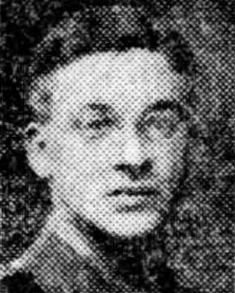
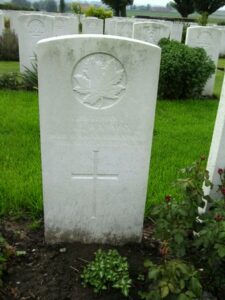
Robert Watson, Sergeant, 189, Australian Infantry. Robert was born at Appleby, Westmoreland in 1880, the elder of the three sons of Charles France Watson and Florence Watson (nee Longstaff). He was the nephew of Mrs. Owen, the wife of the Bishop of St. David’s, who lived at Abergwili Palace. Robert had served during the Boer War with the Royal Garrison Artillery, before emigrating to Australia, where he became a Medical Student. Robert enlisted at Sydney on 21 August 1914 into the newly formed 4th Battalion, Australian Imperial Force, which was part of the 1st Australian Brigade, 1st Australian Division. On 20 October 1914 the ‘Fighting Fourth’ embarked at Sydney aboard H.M.A.T. Euripides, and set sail for Egypt via Ceylon and the Suez Canal. The 1st Australian Division then set up camp in the shade of the Great Pyramids, at Mena Camp, on the outskirts of Cairo, where they trained hard over the coming months, readying for what they thought would be a move to France. However, early in 1915, it had been realised that a bold move was needed to try and break the stalemate that had developed in France, and so the War Office decided on seizing the Gallipoli Peninsula, the key to the Dardanelles Straits, in order to send a naval force to seize Constantinople, and bring Turkey out of the war. On 25 April 1915 the Fighting Fourth landed on the shores of Anzac Cove, as part of the second wave, and saw some terrible fighting over the coming weeks, while trying to break out of their beach-head. Robert was wounded soon after, and was evacuated by Hospital Ship to No. 5 Indian General Hospital at Alexandria, where he died of his wounds on 9 May 1915. The 35-year-old was buried in Alexandria (Chatby) Military Cemetery, Egypt. Robert is not commemorated locally.
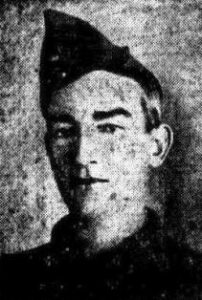
Harry Weatherall, Private, 12107, Welsh Regiment. Harry was born at Wakefield in 1894, the son of Annie Weatherall. Prior to the war he worked as a Farm Servant with the Lodwick family at Spitre, Abergwili. Harry enlisted at Carmarthen into the 8th Battalion, Welsh Regiment soon after the outbreak of war. The battalion was formed at Cardiff in August 1914, moving to Salisbury Plain to join 40 Brigade, 13th (Western) Division. The battalion moved to Chiseldon in October then in December moved again to billets in Bournemouth, where it became converted to the Pioneer Battalion to the 13th Division. In February 1915 the division moved to Aldershot to complete its training, then on 15 June 1915 sailed from Avonmouth for Mudros, before being landed ashore at Anzac, Gallipoli on 5 August 1915, to fight alongside the Anzacs in a great diversionary attack. The 8th Welsh, now reverting to its infantry role, marched out from Anzac Cove on the following day and took up reserve positions at the mouth of Chailak Dere. The 13th Division launched a great assault on Chunuk Bair on 7 August and took its objectives, despite heavy losses, so at dawn on 8 August 1915 the 8th Welsh moved forwards, supported by the heavy guns of the ships deployed offshore. As the battalion crossed Apex Ridge, the men were mown down by heavy machine-gun fire and was almost decimated. Harry survived the assault that day, but was killed in action soon afterwards, on 19 August 1915. The 21-year-old has no known grave, so is commemorated on the Helles Memorial, Gallipoli. Harry is not commemorated on the Abergwili Memorial.
John Williams, Driver, T4/173334, Army Service Corps. John was born in 1880, the son of John Williams and Margaret Williams (nee Davies), of White Mill, Abergwili. Not much is known of his wartime service, but he served in the Army Service Corps, and died at the Barry Military Hospital of pneumonia on 21 December 1918, whilst he was home on leave. The 38-year-old was buried in Pyle (North Cornelly) Calvinistic Methodist Chapelyard.
———————————————————————————————————————–
The Inter War Years – Irish Revolution
Parcell Rees Bowen, MC, DFC and Bar, Captain, Welsh Regiment. Parcell Rees Bowen was the fourth son of Josiah and Mary Bowen, of Pantyglien, Abergwili. Parcell was a student at St. David’s College, Lampeter when he enlisted at the outbreak of War, becoming a Private in the Army Service Corps. He spent the Winter of 1914/15 in France, but in February, 1915 was sent home with badly frostbitten feet. In July that year, he was commissioned as a Second Lieutenant into the 5th Welsh, and he embarked with the Battalion for Gallipoli, where the Battalion formed part of 159 Brigade, 53rd (Welsh) Division. The Division fought at Gallipoli until the evacuation in December, suffering badly from casualties, forcing the 5th Welsh to merge with the 4th Welsh for a short period. After the evacuation, Parcell fought in the Palestinian Campaign, where he then transferred into the Machine Gun Corps, and it was with them that he was awarded his first decoration, the Military Cross. Parcell then transferred into the Royal Air Force on 10 January 1918, becoming an Observer. He gained his second decoration during the air war in Egypt, the Distinguished Service Order. After the Armistice on 11 November 1918, Parcell served in Salonika and Mesopotamia, before being placed on the unemployed list. Again though, Parcell wanted more adventure, and so he volunteered for further service with the R.A.F. in their private war in North Russia, fighting for the White Russians. On 17 July 1919 Parcell arrived at Archangel, where he met his old compatriot from Carmarthen, Ira ‘Taffy’ Jones.
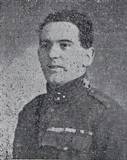
In Ira Jones’s book, ‘An Airfighter’s Scrapbook’, Ira writes glowing reports of Parcell, being glad to see another Welsh Warrior in his Squadron. A long passage from the book tells of an incident that earned Parcell a Bar to his Distinguished Flying Cross. In short, Parcell and his Pilot were carrying out a bombing mission when they came across a superior force of Russian Aeroplanes. Being the men they were, they agreed to attack the Russians, who dispersed in chaos when these two madmen plunged into their midst. The Russians took flight, but one fired a burst of rounds at the British pair, and Parcell and his Pilot were hit. The Pilot fainted at the controls of the aeroplane, and Parcell only had one good arm, but he leaned over his colleague and piloted the aeroplane back nearly 100 miles to base. Parcell was sent home wounded, and again placed on the Unemployed List, so volunteered for a Commission into the Lithuanian Army, with whom he served until July 1920 when he accepted a Government Post.
This post was Top Secret, and involved him going undercover in Dublin, at the time when the troubles were at a peak. Due to the secrecy of the work being carried out in Ireland, nothing much is known about the operations Parcell was engaged in. What is known is that Parcell had been lodging with a fellow Officer at 28, Upper Fitzwilliam Street, Dublin, and the two had spent the afternoon of 27 October 1920 watching a football match at Donnybrook. After the match, Parcell could not be found, until his lifeless body was discovered, lying face down, at Merrion Street. He had been shot in the back by an IRA assassin, the bullet hitting his spine. Parcell’s body was brought back to Carmarthen, where he was buried with full military honours in Abergwili Churchyard. Within a month, on ‘Bloody Sunday’, 21 November 1920, fourteen British Agents were murdered in Dublin by the I.R.A., led by Michael Collins. The British Army reprised the killings by storming into a Gaelic Football match at Croke Park in Dublin, and fired into the crowd to avenge their murdered colleagues, inflicting many casualties, with fourteen men and children dead. Later that night, three IRA prisoners suspiciously died in captivity in Dublin Castle, and the situation swiftly escalated. The Irish Public quickly turned against the Crown, and Peace negotiations ensued, resulting in a truce being declared on 11 July 1921. *Please note that the photographs relating to Parcell originate from myself but have been copied and used on an Irish website without permission or acknowledgement.*
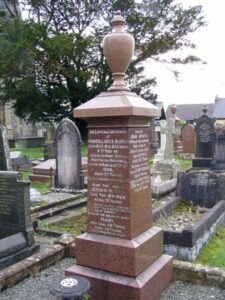
———————————————————————————————————————–
World War Two, 1939-1945
Frank Ernest Burtenshaw, Second Radio Officer, Merchant Navy. Frank was born in Coggleshall, Essex on 11 August 1923, the son of George Albert Burtenshaw and Florence Adele Burtenshaw (nee Taylor). His father was a Water Bailiff and prior to the war had moved the family to Milling, Rhos, Haverfordwest. His mother died in 1938 and his father remarried to Augusta Mary Neuzerling, before moving to St. Anthony’s Lodge, Llansteffan. Frank worked for the Postal Service as a Telegraphist at Carmarthen and resided at Tegfan, Abergwili. He joined the Merchant Navy soon after the outbreak of war and was posted aboard the RFA Gray Ranger. The Ranger Class were the first class of tanker built for the Royal Fleet Auxiliary since the First World War. The Gray Ranger measured 349ft in length, 47ft in breadth and 20ft in draught. The funnel was positioned on the port side and it was fitted with a derrick at the beam to facilitate fuelling at sea. The Gray Ranger could carry 2,600 tons of fuel oil, 550 tons of diesel and 90 tons of petrol. On 2 September 1943, Convoy PQ.18 departed from Loch Ewe, bound for Archangel in Russia. Among the Convoy was the RFA Gray Ranger. After unloading their cargoes at Archangel, the Convoy (renumbered Q.P.14) sailed on 13 September bound for Loch Ewe. On 22 September 1942, nine days into the voyage and almost safely in home waters, the Gray Ranger was torpedoed by the German Type VIIC U-Boat U-435. She suffered irreparable damage to her engines, so was scuttled and sank in the North Sea. Frank was killed in the explosion that day. The 19-year-old has no known grave so is commemorated on the Tower Hill Memorial, London.
John Myrddin Evans, Lieutenant, 308055, Royal Artillery. John was born on 27 July 1915, the son of George Evans and Elizabeth Evans (nee Morris), of 47, High Street, Abergwili. He married Margaret Edna Evans, a Chemists Assistant, of 15, Farrar Street, Carmarthen in 1943. John enlisted into the Royal Artillery and on 5 February 1944 was commissioned as Second Lieutenant from the Officer Cadets. He was then posted to France from the 45th Reinforcement Holding Unit. Nothing more is currently known of which unit he was posted to, but he was wounded on 23 November 1944, during the drive through Holland towards the Rhine, and was eventually evacuated back home. John died in Carmarthen on 3 October 1945. For some reason the burial site of the 30-year-old is unknown, so he is commemorated on the Brookwood Memorial, Surrey.
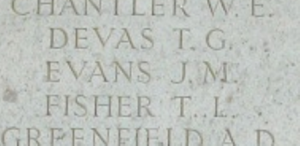
Gwyneth Mary Henton, Aircraftwoman 2nd Class, 2076298, Women’s Auxiliary Air Force. Gwyneth was born on 18 October 1923, the daughter of Edward Charles Henton and Mary Henton (nee Jones), of Merlin’s Villa, White Mill. She served with the Women’s Auxiliary Air Force, which had been established on 28 June 1939 for non-combat roles. Gwyneth died at Carmarthen on 9 December 1941 of broncho-pneumonia, which she had contracted on active service. She was just 18 years old. For some reason she is not commemorated by the CWGC, but she is buried with her parents at Abergwili.
David H. Jones, Corporal, Royal Air Force Police. Nothing is yet known about David at present, but the Memorial states that he died in Carmarthenshire during May 1948 aged 28. This would have been too late for him to be recorded as an official casualty of the Second World War by the Commonwealth War Graves Commission.
Herbert Llewelyn Jones, Sergeant (Flight Engineer), 570542, Royal Air Force. Herbert was born on 2 January 1921, the son of David John Jones and Esther Elizabeth Jones (nee Walters), of 51, High Street, Abergwili. His mother Elizabeth died in 1923, and Herbert went to live with his grandparents, John and Harriet Jones and at Brynderwen, Llanarthney. After leaving his local school at Llanarthney, Herbert gained a place in Carmarthen Grammar School. He enlisted into the Royal Air Force upon leaving school and after completing his training as a Flight Engineer was posted to 9 Squadron, Royal Air Force, which was a medium bomber Squadron, originally equipped with the Vickers Wellington. The squadron utilised their Wellington’s on anti-shipping sorties in the early stages of the war, before converting to Avro Lancaster’s in September 1942 and joined RAF Bomber Command, based at RAF Waddington. On the night of 4 April 1943 Herbert took off from Waddington aboard Avro Lancaster, Serial ED696 which was part of a force bound for Kiel. The Lancaster was intercepted by a German night-fighter on the following morning, 5 April 1943, and crashed in flames near Grossenaspe, killing all seven of her crew. Herbert, who was just 22 years old, was buried alongside his fellow crewmen in Neumunster Civil Cemetery, but their graves were later exhumed and they were re-interred in Hamburg Cemetery, Germany in September 1946. Herbert is not commemorated on the Abergwili War Memorial.
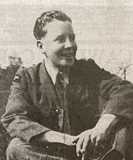
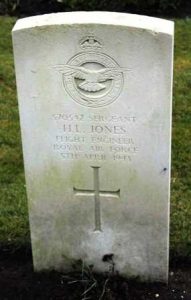
Desmond Lewis, Sergeant, 1414771, Royal Air Force Volunteer Reserve. Desmond was born in 1925, the son of William Titus Lewis and Margaret Lewis (nee Evans), of 55, Abergwili Road, Carmarthen. After leaving Carmarthen Grammar School he enlisted into the Royal Air Force Volunteer Reserve and after completing his training as an Air Bomber, he was posted to 429 (Royal Canadian Air Force) Squadron, Royal Air Force, which flew the Vickers Wellington Mark X based at RAF East Moor. On the night of 26 January 1943, Desmond took off from East Moor aboard a Vickkers Wellington III, Serial BK163, which joined a force of 156 other bombers sent to bomb the U-Boat pens at Lorient, in France. Desmond was killed, together with his entire crew, when their Wellington was lost without trace on the following morning, 27 January 1943. Desmond was just 17 years old when he was killed that night. He has no known grave, so is commemorated on the Runnymede Memorial, Surrey. He was in fact one of the youngest men to be killed serving with Bomber Command during the war.
John Chapman Oliver, Rifleman, 7012565, 1st Airborne Battalion, Royal Ulster Rifles. John was born in 1906, the son of John Oliver and Sarah Oliver. He married Francis Nest Lewis, of Abergwili, in the autumn of 1941. John enlisted into the army and served in the 1st Battalion, Royal Ulster Rifles, which had been stationed in India at the outbreak of hostilities, but returned in time to help defend Dunkirk and evacuate the British Expeditionary Force. The Battalion became a part of the 31st Independent Infantry Brigade billeted in Wales, where they assumed a coastal defence role. At this stage in the war, the British Airborne Forces consisted of just the 1st Parachute Brigade, however in September 1941, the War Office decided that a Brigade of glider infantry should be raised to compliment them. The 31st Infantry Brigade was selected for this task and on 10 October that year, it was renamed the 1st Airlanding Brigade. The 1st Parachute Brigade had been detached since late 1942 and had been involved in heavy fighting in North Africa. The 1st Airlanding Brigade was called to join them in May 1943 to prepare for an invasion of Sicily. The 1st Royal Ulster Rifles and 2nd Oxfordshire and Buckinghamshire Light Infantry were detached to form the experienced nucleus of the 6th Airlanding Brigade. As a part of the newly raised 6th Airborne Division, and landed at on 6 June 1944 near Ranville. Their task was to help enlarge the southern sector of the bridgehead by capturing the villages of Longueval and Sainte Honorine. The first of these was taken without incident, however the attempt to move on the second was dogged by communications difficulties and determined German resistance. The Battalion was forced to retire to Longueval, having suffered in excess of one hundred casualties, the overwhelming majority of which were either wounded or missing. The Ulstermen remained in this area for the following week and endured a great deal of shelling and numerous harassing attacks throughout, although no truly serious attempt was made to dislodge them. John was Killed in Action during the successful capture of Longueval on 7 June 1944, just a day after D-Day. John was 38 years old, and is buried in Ranville War Cemetery, France.
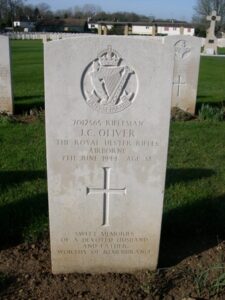
David John Dudley Thomas, Sergeant, Royal Air Force Volunteer Reserve. David was born on 13 April 1922, the son of Mansel Thomas and Elizabeth Thomas (nee Phillips), of Porthyrhyd, Tanerdy, Carmarthen. He worked as a painter with his father prior to enlisting into the Royal Air Force Volunteer Reserve and after completing his training as a Wireless Operator/ Air Gunner, was posted to 226 Squadron, Royal Air Force, a medium bomber squadron which flew the Douglas Boston IIIA, based at Swanton Morley. On 25 January 1943 David took off from Swanton Morley aboard a Douglas Boston III, Serial W8354, which joined a number of other aircraft despatched to strike targets in Flushing Docks, in Vlissingen. David and his three fellow crewmen were killed when their Boston was hit by Naval flak and crashed near Vlissingen Airfield. The 20-year-old was buried besides his fellow crewmen in Flushing (Vlissingen) Northern Cemetery, Netherlands.
